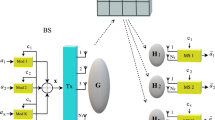Abstract
Non-orthogonal multiple access (NOMA) can share the same frequency band with multiple mobile devices. In the conventional NOMA scheme, the possible pairs of users are limited and this limitation restricts the amount of capacity improvement. This is because the receiver only for the near user cancels the signal of the other user and then detect the desired signal. In this paper, the effect of joint detection in the far user of the NOMA downlink is evaluated through constellation constrained capacity. It allows the pairing of users with the difference of the propagation losses of less than 8 dB. The possible number of user pairs in the NOMA system then increases and a larger total capacity may be achievable.















Similar content being viewed by others
References
Assessment of the Global Mobile Broadband Deployments and Forecasts for International Mobile Telecommunications, Report ITU-R, M2243 (2012).
Kishiyama, Y., Benjebbour, A., & Nakamura, T. (2008). Superimposed radio resource sharing for improving uplink spectrum efficiency. The 14th Asia-Pacific conference on communications.
Osada, H., Nishimura, H., Inamori, M., & Sanada, Y. (2011). Adjacent channel interference cancellation in fractional sampling OFDM receiver. IEEE 74th vehicular technology conference.
Takeda, T., & Higuchi, K. (2011). Enhanced user fairness using non-orthogonal access with SIC in cellular uplink. IEEE 74th vehicular technology conference.
Tomida, S., & Higuchi, K. (2011). Non-orthogonal access with SIC in cellular downlink for user fairness enhancement. IEEE intelligent signal processing and communication systems.
Osada, H., Inamori, M., & Sanada, Y. (2012). Non-orthogonal access scheme over multiple channels with iterative interference cancellation and fractional sampling in OFDM receiver. IEEE 75th vehicular technology conference.
Osada, H., Inamori, M., & Sanada, Y. (2012). Non-orthogonal access scheme over multiple channels with iterative interference cancellation and fractional sampling in OFDM receiver. IEICE Transactions on Communications, E95–B(12), 3837–3844.
Higuchi, K., & Kishiyama, Y. (2012). Non-orthogonal access with successive interference cancellation for future radio access. In Proceeding of the 9th IEEE VTS Asia Pacific wireless communications symposium (APWCS) (pp. 23–24). Kyoto, Japan.
Benjebbour, A., Li, A., Kishiyama, Y., & Nakamura, T. (2013). System-level performance of downlink NOMA for future LTE enhancements. 2013 IEEE Globecom Workshops.
Yamamoto, K., Saito, Y., & Higuchi, K. (2014). System-level throughput of non-orthogonal access with SIC in cellular downlink when chanel estimation error exists. The 77th IEEE vehicular technology conference
Study on Network-Assisted Interference Cancellation and Suppression (NAIC) for LTE, 3GPP TR 36.866 V12.0.0 (2014).
Higuchi, K., & Benjebbour, A. (2015). Non-orthogonal multiple access (NOMA) with successive interference cancellation for future radio access. IEICE Transactions on Communications, E98–B(3), 403–414.
Tse, D., & Viswanath, P. (2008). Fundamentals of wireless dommunication. Cambrige: Cambrige University Press (Fouth Printing).
Saito, Y., Benjebbour, A., Kishiyama, Y., & Nakamura, T. (2013). System-level performance evaluation of downlink non-orthogonal multiple access (NOMA). IEEE 24th international symposium on personal. Indoor, and mobile radio communications
Benjebbour, A., Saito, Y., Kishiyama, Y., Li, A., Harada, A., & Nakamura, T. (2013). Concept and practical considerrations of non-orthogonal multiple access (NOMA) for future radio access. IEEE international symposium on intelligent signal processing and communication systems 2013.
Ungerboeck, G. (1982). Channel coding with multilevel/phase signals. IEEE Transactions on Information Theory, IT–28(1), 55–67.
Hagh, M., & Reza, M. (2012). Application of Raptor coding with power adaptation to DVB multiple access channels. IEEE Transactions on Broadcasting 58(3)
Hagh, M., & Reza, M. (2013). Constellation rotation for DVB multiple access channels with Raptor coding. IEEE Transactions on Broadcasting, 59(2), 290–297.
Acknowledgments
This work is supported in part by a Grant-in-Aid for Scientific Research (C) under Grant No. 24520382 from the Ministry of Education, Culture, Sport, Science, and Technology in Japan.
Author information
Authors and Affiliations
Corresponding author
Rights and permissions
About this article
Cite this article
Yazaki, T., Sanada, Y. Effect of Joint Detection in Far User on Non-orthogonal Multiple Access Downlink. Wireless Pers Commun 89, 1203–1219 (2016). https://doi.org/10.1007/s11277-016-3312-y
Published:
Issue Date:
DOI: https://doi.org/10.1007/s11277-016-3312-y




